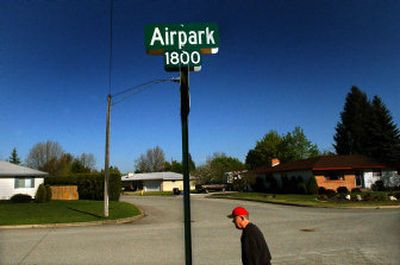Airpark idea still soars in imagination

Back when Chuck Pierce was learning to fly a plane, it was common for flight instructors to guide their students over the southeast corner of Spokane Valley and kill the engines.
As gravity kicked in, Pierce and other newbies were told to gaze down at the rapidly approaching terra firma in order to find a safe place to land. It was 1960 and there wasn’t much to zero in on – a few truck farms, some pasture land; that was about it.
But if a pilot looked twice, he might have seen a tiny stucco house at the corner of 16th and Adams and a 3,200-foot stretch of dirt cocked 210 degrees to the southwest, an angle shared by most runways in the region because it parallels the prevailing wind, an angle around which Loren Lemen, the occupant of the little stucco house, planned to build the neighborhood of the future.
“It didn’t take student pilots very long to know where it was. If you were going to get an emergency landing or a dead engine pulled on you, it was going to be out there,” Pierce said. “Almost everybody knew Loren.”
Lemen had run a crop-dusting and air mechanics business at 16th Avenue and Adams Road since the 1940s. As the housing boom of the late 1950s began filling Spokane Valley’s vacant lots, Lemen turned his attention to development.
But Lemen wasn’t interested in little boxes on the hillside. He wanted to build a neighborhood on his land in Veradale with a plane in every garage, a neighborhood for, as he told the news hounds who came gawking, “air-minded” people.
“More and more people, particularly businessmen, are using private planes to cut down traveling time,” Lemen told the Spokane Chronicle in 1955. “We believe that a housing development designed especially for these and other air-minded people will be a definite service to the Valley.”
Reporters went wild with possibilities of a propeller-spun nuclear family living in Lemen Airpark.
“Pretty soon in Vera, it will be, ‘Dad, can I use the plane today?’ ” one reporter wrote. “Husbands will check over the family aircraft for signs of damage after wives have taxied the planes into hangars next to homes.”
The 300-home project broke ground in 1955 on 160 acres. The plan was for 34 homes on two streets paralleling the runway. Each hangar was to have direct access to the airfield. Residents living off the runway were to be given space in a community hangar behind Lemen’s house. The projected prices of the homes in the airpark seemed to go up with each report, from $12,000 to $15,000 in July 1955, to $50,000 that November. There were even plans for private parks complete with swimming pools.
“He was so far ahead of everybody else,” said Ed “Skeeter” Carlson, a Spokane pilot who landed at Lemen’s a time or two. He admired the airpark, but it was a little too rich for his blood.
“When I got out of the Army, most of my buddies were buying houses with their G.I. bills for $6,000,” said Carlson, who at age 83 still flies a small plane. “One guy bought an $8,000 house and we thought he was rich.”
But the airpark soon morphed into something else. Within a year of receiving county approval, the original plat was partially overlaid with a more modest, non-plane subdivision of 425 homes. The new project, simply called Valley Park, kept the promise of a private park and pool but didn’t mention the runway. By 1958, the last of Lemen Airpark was bought by Fidelity Savings and Loan, which didn’t limit sales to air-minded people.
Loren Lemen, now 90 and living in Seven Bays at Lake Roosevelt, has a hard time explaining what happened to his neighborhood of the future.
“It’s nothing that happened overnight,” said Lemen. “I already had the strip and so on and so on. In other words, it’s hard to understand.”
Today, from overhead you can still see where the runway used to be, though it is now filled in with split-level homes. Early Dawn and Airpark drives parallel the 3,200-foot strip. There is a private park and a pool near 16th and Bolivar Road, just as promised by the neighborhood of tomorrow.
“I know our house is still there and our hangar,” said Loren’s wife, Lelah.
The neighborhood of tomorrow is the neighborhood of her past. When she talks about the airpark, she tells a more personal story, about Loren working out in the garage or taking off to go crop-dusting. Inevitably, someone always called when her husband’s low-flying plane buzzed the Valley landscape; crop-dusters always fly low.
She talks about the winter months, when Loren would shoot coyotes from the sky and return home with their pelts tied to the struts of his plane. And she talks about her son, Bill, and the other children in the neighborhood who would pile into a couple of broken-down planes on the Lemens’ property and, as she puts it, “go all over the world,” on the breeze of imagination.
They could even fly into the future.